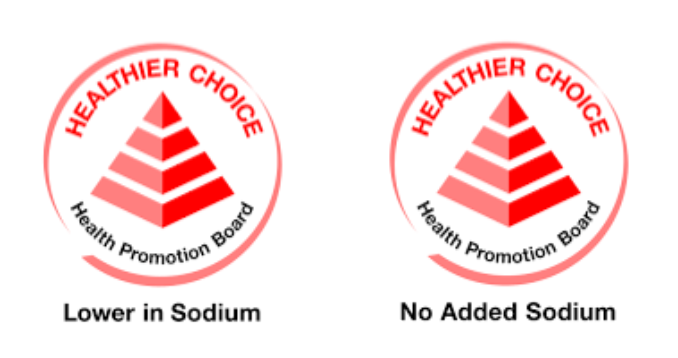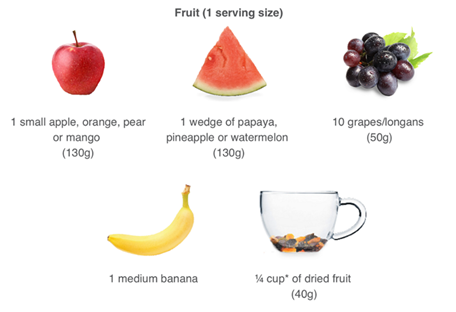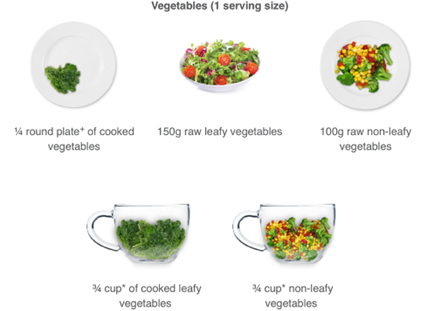Heart disease includes a range of conditions that affect the heart. You can prevent or improve many types of heart disease by making healthy lifestyle choices. Following a healthy diet is one of the strategies to manage your heart health.
Tips for a Healthy Heart
1. Consume a Variety of Heart-healthy Foods from all Food Groups and Follow their Recommended Serving Size
- Wholegrains: choose brown rice, red rice, wholemeal or wholegrain bread, wholemeal noodles or chapati
- Lean meats/ fish/ poultry/ seafood: choose skinless poultry or lean meats
- Nuts, seeds and legumes: choose non-fried, unsalted nuts or dried legumes as snacks or add them into your dishes
- Fruits and vegetables: consume a variety of different coloured fruits and vegetables across the colours of a rainbow
To identify the recommended number of servings suitable for your needs, please refer to the chart below:
with permission by Health Promotion Board, Singapore
2. Adopt a Low Salt Diet
Diets higher in salt are associated with an increased risk of developing heart disease.
Aim for no more than 2000 – 2400mg of sodium a day. That's about 1 teaspoon (5g) of salt!
Tips to Reduce Sodium Intake
When cooking at home:
- Use salt, seasoning and sauces sparingly
- Use fresh herbs and spices to flavour food (e.g. curry powder, pepper, garlic, vinegar, lemon, oregano, basil, parsley, and many more!)
- Use fresh vegetables when cooking soup to replace ready-to-use broth
- Choose foods that requires minimal preparation, such as broiled, baked or roasted meats made without sauces, breading or batter
When grocery shopping:
- Choose fresh produce over processed (e.g. sausages, hams, luncheon meats, instant noodles and microwave meals) or preserved food items (e.g. canned pickled lettuce, salted vegetables and kimchi)
- Choose food products labelled with the "No Added Sodium" or "Lower in Sodium" Healthier Choice Symbols

- Choose food products which do not list sodium as the first few ingredients or appear multiple times in the ingredient list. Sodium can be listed as salt, sea salt, vegetable salt, rock salt or compounds with sodium in its name (e.g. sodium bicarbonate, monosodium glutamate and sodium metabisulphite).
- You may consider reduced-sodium salt substitutes. If you have kidney disease or take certain medications for high blood pressure or heart disease, ask your dietitian or doctor about using salt substitutes.
When eating out:
- Leave soup behind and avoid excess gravy
- Avoid dipping sauces
- Choose plain rice over flavoured rice
- Consume less fast food
3. Boost your Fibre Intake
Eating more fibre can help to reduce your cholesterol levels and reduce the risk of heart diseases. Increase intake of fruits, vegetables, oatmeal, whole grain and legumes. Aim to consume at least half of your total grain intake as wholegrains, with two servings of fruits and vegetables each daily.

My Healthy Plate - fruit serving sizes reproduced from https://www.healthhub.sg with permission by Health Promotion Board, Singapore

My Healthy Plate - fruit serving sizes reproduced from https://www.healthhub.sg with permission by Health Promotion Board, Singapore
4. Choose Food Higher in Unsaturated Fat and Go Easy with Food High in Saturated Fat and Trans Fat
Healthier choices when snacking or cooking:
- Choose a handful of unsalted nuts (30g), few times a week
- Limit potato chips, doughnuts, pastries, cakes, cookies, frozen pizza, frozen fried food
- Limit processed meats, such as bacon, sausages, ham, cured meat, luncheon meat, bak kwa
- Choose oily fish high in omega 3, a polyunsaturated fat, at least twice a week (e.g. mackerel, salmon, sardine)
- Replace red meat with plant based proteins such as beans, legumes, lentils or tofu
- Choose spreads with higher unsaturated fat content (e.g. olive oil or canola oil soft margarine)
- Avoid using animal fat in cooking (e.g. lard, ghee, duck fat)
- Choose low-, non- or ‘light’ versions of milk or coconut milk
- Avoid high fat cooking methods
Healthier choices when eating out
- Choose lean cuts of meat and poultry and remove any visible fat and skin
- Choose noodles in clear soup (e.g. wonton noodle soup) over noodles in gravy or fried/ dry noodles (e.g. char kway teow)
- Choose plain brown/ white rice over flavoured rice (e.g. chicken rice, nasi lemak, nasi briyani)
- Choose dishes cooked without coconut milk
- Avoid adding fried shallots, sauces, and gravies

5. Go Easy on Sweetened Food and Drinks
Consuming too much sugar may increase triglyceride levels and lead to weight gain. The Health Promotion Board recommends having no more than 10 teaspoons of sugar each day. This recommendation is based on a 2000 calorie diet. Reducing to 5 teaspoons of sugar daily can help you lose weight and improve your health.
Examples include:
- Brown sugar, white sugar, rock sugar, gula melaka, sugar syrup, honey, coconut palm sugar, fructose, corn syrup, agave nectar
- Condensed milk
- Candies
- Dried fruits with added sugar
- Canned fruits in syrup
- Cakes, brownies topped with fondant, topping or icing
- Sweet spreads (e.g. jam, kaya)
- Sugar sweetened drinks
6. Include Plant Sterols Daily
Plant sterols are effective in lowering cholesterol if you eat enough of them as part of a heart healthy diet. The recommended amount of plant sterols is 2g a day. Aim for 2-3 servings of milk fortified with plant sterols to achieve a total of 2g a day.
7. Consume Alcohol in Moderation
Drinking too much alcohol can increase triglyceride levels and lead to weight gain. If you drink alcoholic beverages, do so in moderation. Keep to 2 standard drinks per day for men and 1 standard drink per day for women.
One standard alcoholic drink comprises:
- 1 can (330 ml) of regular beer
- ½ glass (100 ml) of wine
- 1 nip (30 ml) of spirit
8. Quit Smoking and Exercise Regularly
Besides healthy eating, a healthy lifestyle can reduce your risk of getting heart disease. Smoking may increase the risk of heart disease, raise blood pressure and reduce your “good” (HDL – High Density Lipoprotein) cholesterol level. Regular exercise, especially aerobic exercise, can help to reduce blood pressure and improve your HDL cholesterol level.
If needed, talk to your doctor or physiotherapist before starting an exercise plan, especially after a medical procedure.
